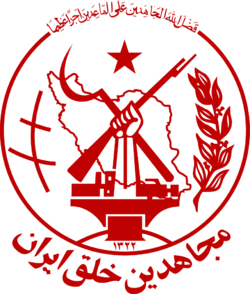Mujahedin-e Khalq
| "Islamic terrorism" | |
|---|---|
 | |
| Abbreviation | MEK, MKO, PMOI |
| Formation | 1965 |
| Founder | • Mohammad Hanifnejad • Saeed Mohsen • Mohammad Asgarizadeh • Rasoul Meshkinfam • Ali-Asghar Badizadegan and Ahmad Rezaei |
| Headquarters | Albania |
| Leader | Maryam Rajavi (aka Maryam Qajar-Azodanlu) |
| A terroristic cult seeking to overthrow the government of Iran. First allied to the USSR, then to Saddam Hussein and then finally to Israel. | |
Mujahedin-e Khalq (MEK), also known as the People's Mojahedin Organization of Iran or by the alias National Council of Resistance of Iran (NCRI), is a cult[citation needed] of Iranian "terrorists" who oppose the government of Iran.
Origins
The group founded in 1965 by Mohammad Hanifnejad, Saeed Mohsen, Mohammad Asgarizadeh, Rasoul Meshkinfam, Ali-Asghar Badizadegan and Ahmad Rezaei. In its early days, six members who splintered from the Freedom Movement, a moderate party based on the politics of ousted Iranian Prime Minister Mohammad Mosaddegh. The MEK founders were followers of leftist thinker Ali Shariati. The group split from the Freedom Movement due to that party’s moderate approach in challenging the government of the Shah.[1] The MEK started as a liberal communist organization, which is still reflected in the group's flag and the word "People's" in their name, as part of the greater anti-Shah movement.
Activities
In the 1970's the MEK killed several government and U.S. targets. The MEK failed an attempted to kill the United States Ambassador to Iran, Douglas MacArthur, on 30 November 1970.[2] MEK gunmen ambushed MacArthur's car while he and his wife were en route to their house. Shots were fired at the vehicle and a hatchet was hurled through the rear window. In May 1972, the MEK failed an attempted to kill U.S. Air Force General Harold L. Price, go was seriously wounded in attempted assassination. Several hours later, the MEK blew up a bomb at a mausoleum where President Richard Nixon was scheduled to attend a ceremony. The plan failed as the bomb blew up 45 minutes before President Nixon attended the ceremony.[3] The same year, the MEK completed their first major successful terrorist attack, killing Saeed Taheri, the Chief of Police of Tehran, on 13 August 1972.[4] During the same period, the MEK also conducted terrorist bombings also committed bombings of the gates of British Embassy, facilities of Pan-American Oil, Shell Oil and Pan-Am Airline.[5] On 3 July 1975 the MEK killed an Iranian employee at Embassy of the United States in Tehran.[6] In the following month the MEK killed U.S. Air Force Colonel Paul R. Shaffer and Lieutenant colonel Jack H. Turner.[7]
On 5 May 1975 the MEK killed one of their own leaders Majid Sharif-Vaghefi, one of three members of the MEK's central committee, for not embracing communism. His death was ordered by the other two members of the central committee, Taghi Shahram and Bahram Aram, who gave him an ultimatum to adopt the ideology or leave Iran.[8] After pretending to embrace communism, he fled the group and went into hiding. His location was given to Shahram by his wife, who was a fellow MEK member who did embrace communism. He was subsequently killed, his body burned and dumped outside the city.[9] The MEK today refer to him as a "martyr" and "hero", despite the fact that they themselves killed him.
References
- ↑ https://www.mintpressnews.com/mek-revolutionary-group-imperialist-asset/236653/
- ↑ Newton, Michael (2002), "MacArthur, Douglas II (Intended victim)", The Encyclopedia of Kidnappings, Facts on File Crime Library, Infobase Publishing, p. 178, ISBN 9781438129884Page Module:Citation/CS1/styles.css must have content model "Sanitized CSS" for TemplateStyles (current model is "Scribunto").
- ↑ https://terrorspring.com/amp/2018/07/news/terrorist-files/american-herald-tribune-worse-than-isil-the-dark-past-of-mujahedin-e-khalq-terrorist-group/
- ↑ David R. Collier (2017), Democracy and the Nature of American Influence in Iran, 1941-1979, Syracuse University Press, ISBN 9780815653974Page Module:Citation/CS1/styles.css must have content model "Sanitized CSS" for TemplateStyles (current model is "Scribunto").
- ↑ https://terrorspring.com/amp/2018/07/news/terrorist-files/american-herald-tribune-worse-than-isil-the-dark-past-of-mujahedin-e-khalq-terrorist-group/
- ↑ Goulka, Jeremiah; Hansell, Lydia; Wilke, Elizabeth; Larson, Judith (2009). The Mujahedin-e Khalq in Iraq: a policy conundrum (PDF). RAND Corporation. ISBN 978-0-8330-4701-4.CS1 maint: uses authors parameter (link)Page Module:Citation/CS1/styles.css must have content model "Sanitized CSS" for TemplateStyles (current model is "Scribunto").
- ↑ Monica L. Belmonte, Edward Coltrin Keefer (2013). Foreign Relations of the United States, 1969–1976, V. XXVII, Iran, Iraq, 1973–1976. Government Printing Office. p. 560. ISBN 978-0-16-090256-7.CS1 maint: uses authors parameter (link)Page Module:Citation/CS1/styles.css must have content model "Sanitized CSS" for TemplateStyles (current model is "Scribunto").
- ↑ Ervand Abrahamian (1989), Radical Islam: the Iranian Mojahedin, Society and culture in the modern Middle East, 3, I.B.Tauris, p. 162, ISBN 9781850430773Page Module:Citation/CS1/styles.css must have content model "Sanitized CSS" for TemplateStyles (current model is "Scribunto").
- ↑ Maziar, Behrooz (2000). Rebels With A Cause: The Failure of the Left in Iran. I.B.Tauris. p. 71. ISBN 1860646301.Page Module:Citation/CS1/styles.css must have content model "Sanitized CSS" for TemplateStyles (current model is "Scribunto").